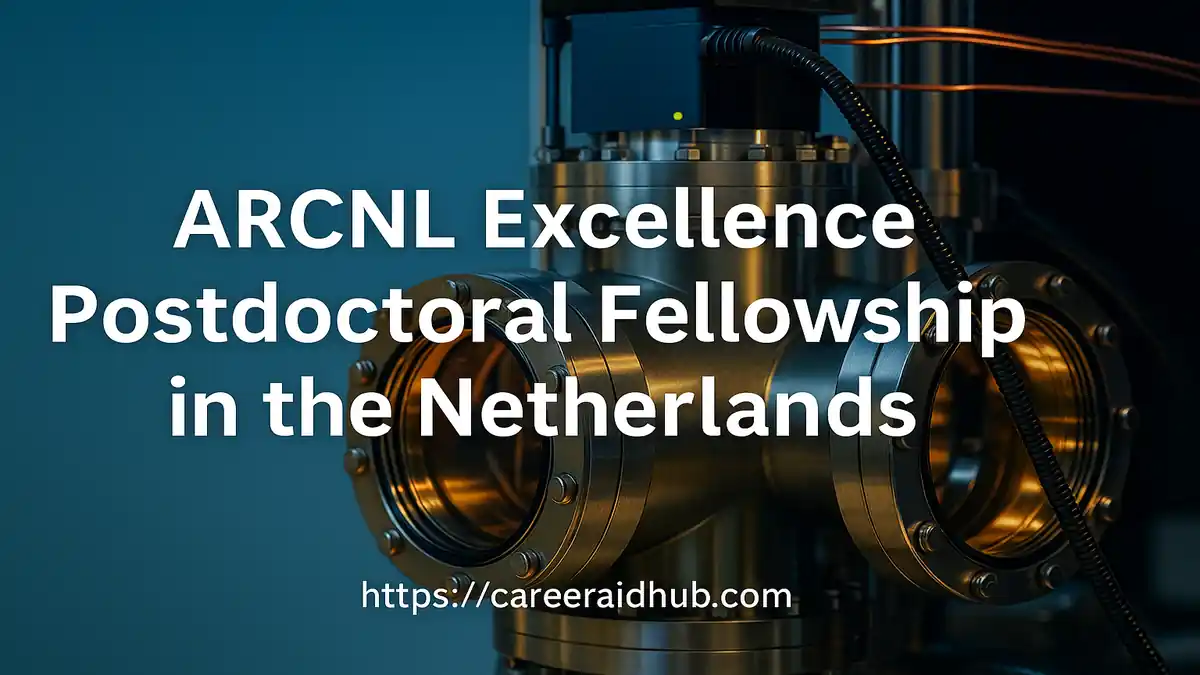PhD/Postdoc Opportunity: Fundamental Insights into In-Situ Degradation of Battery Electrodes (Germany)
Why this project matters
Modern lithium-ion and solid-state batteries fail not only from bulk fatigue but also through subtle, interfacial changes: redox-driven reconstruction, gas evolution, SEI growth, and stress-assisted cracking. Capturing those processes as they happen is crucial for designing longer-lived, recyclable cells. This role puts you at that frontier—linking atomic-scale observations to mechanistic models that guide materials choices and operating windows. The project specifically targets mechanistic insights into ion-transport-mediated surface reactions and interface migration during solid-state electrochemistry and recycling, using in-situ instrumentation to drive and monitor reactions under realistic stimuli.
Join a high-impact project decoding how battery electrodes degrade under in-situ operating conditions. A PhD/Postdoc role at the Max Planck Institute for Sustainable Materials (Düsseldorf) blends advanced TEM/operando methods with theory to reveal mechanisms that limit performance and enable longer-lasting, recyclable batteries.
What you will do
You will join the Atomic Scale Dynamics of Sustainable Materials group and lead in-situ experimentation supported by analysis and interpretation:
-
- Apply electrical bias—and where relevant temperature and reactive gases—to electrode materials using gas-cell holders to provoke and probe material transformations under controlled environments.
- Use advanced in-situ SEM/TEM to quantify interface migration, nucleation, and phase transformations in real time.
- Develop theoretical interpretations to explain the underlying mechanisms and to guidemodification pathways (e.g., coatings, dopants, or process parameters) that mitigate degradation.
- Publish in peer-reviewed venues and present at international conferences; contribute to the group’s collaborative methods culture.
These responsibilities are intentionally balanced across operando methods, quantitative analysis, and mechanism-driven modeling, ensuring your work translates from observation to actionable design rules.
What you need to bring
-
- Background: Master’s (for PhD track) or PhD (for Postdoc) in Materials Science, Materials Chemistry, Materials Physics, or closely related fields.
- Core skill: Transmission Electron Microscopy (TEM) hands-on experience is mandatory; prior TEM-based in-situ operation is a strong plus.
- Foundations: Solid grasp of thermodynamics and electrochemistry of materials, with the ability to connect microstructure to electrochemical behavior.
- Language: Excellent English (spoken and written); it’s the institute’s working language.
Who thrives here? Curious experimentalists who enjoy building and iterating operando setups, quantifying kinetics and morphology changes, and then closing the loop with mechanism-aware hypotheses that can be tested again in the microscope.
Training environment and supervision
You’ll work in a stimulating, collaborative international environment with world-class microscopy facilities and a culture that values open methods,
Alongside local expertise, the broader Max Planck ecosystem around sustainable materials and energy provides complementary theory and data workflows, offering opportunities to link in-situ observations with modeling and design, and to align with initiatives that accelerate discovery.
Techniques you’ll likely use (and develop)
-
- Gas-cell in-situ TEM/SEM: Apply potential, temperature, and controlled atmospheres to observe reaction pathways under operating conditions.
- Interface tracking: Quantify migration, coarsening, and phase boundary kinetics with high temporal resolution.
- Correlative analysis: Integrate operando microscopy with complementary post-mortem or ex-situ tools as needed (e.g., site-specific FIB prep, spectroscopy) to validate mechanisms. Context from institute battery-materials work.
- Mechanism-guided interpretation: Use thermodynamic/electrochemical reasoning to map observed transformations to driving forces and suggest mitigation strategies.
Example scientific questions
-
- How do ion transport and electric fields couple at buried interfaces to trigger migration and reconstruction during cycling?
- Under what gas/temperature/bias conditions do interphase layers form, and how do they evolve?
- Which coatings or dopants stabilize interfaces without hindering kinetics, and how can we verify this in situ?
These are illustrative; the project’s explicit remit is to derive new mechanistic insight thatinforms longer-life, safer, and more recyclable battery designs.
Application package and how to apply
Prepare the following and submit via the online application link on the official posting:
-
- CV, motivation letter, transcripts, degree certificates, list of publications (if applicable), and two reference letters.
Applications are due by 26 October 2025. As a best practice, contact referees early and verify transcripts/certifications. If selected, you’ll be contacted for next steps by the group.
Equity and inclusion: The Max Planck Society is committed to diversity and equal opportunity and explicitly welcomes applications from candidates of all backgrounds, including those with disabilities.
Career outcomes and why this role is timely
Industry and academia are both racing to improve durability and recyclability of electrode systems as pack standards tighten and second-life uses expand. Expertise in operando microscopy, interfacial mechanisms, and degradation mapping is therefore highly transferable—to cell manufacturers, materials suppliers, and research labs. Moreover, global roadmaps increasingly emphasize mechanism-first design: learning how and why materials fail under realistic conditions, then engineering interventions to prevent those pathways. This project equips you with exactly that playbook—instrumentation, interpretation, and impact. Contextual alignment with the institute’s sustainable materials push and battery-focused research.
Practical tips for a strong application
-
- Anchor your narrative in a specific degradation problem youstudied (e.g., cathode interfacial reconstruction, SEI growth under high voltage). Explain what you measured, what changed, and why it matters.
- Show tool fluency: Describe the in-situ or operando setups you’ve used (holders, biasing schemes, temperature control, atmosphere) and how you handled alignment, drift, and time-resolved acquisition.
- Quantify rigor: Mention calibration routines, error bars, and how you separated instrument artifacts from real signals.
- Propose a Year-1 plan: A tractable experiment to validate a mechanism—e.g., bias- and gas-dependent migration rate mapping across a specific interface—with decision criteria for next steps.
- Connect to mechanisms: Bring thermodynamics/electrochemistry forward—chemical potentials, diffusivities, reaction fronts—so your story goes beyond images to cause-and-effect.
- Anchor your narrative in a specific degradation problem you
How to get started
Review the official vacancy for full details and use the Apply online now link. If your background aligns and you have hands-on TEM experience, this is a compelling chance to contribute to enduring battery reliability—from first principles observed live in the microscope to design rules that stick.
| Item | Details |
|---|---|
| Opportunity | PhD / Postdoc – In-Situ Degradation of Battery Electrodes |
| Institute | Max Planck Institute for Sustainable Materials, Atomic Scale Dynamics of Sustainable Materials |
| Location | Düsseldorf, Germany |
| Focus | Mechanistic insights into ion-transport-mediated interfacial reactions and interface migration under operando conditions |
| Techniques | In-situ TEM/SEM (gas-cell, biasing, temperature), interface tracking, FIB prep, spectroscopy, correlative ex-/post-mortem analysis |
| Responsibilities | Design operando experiments, quantify kinetics/phase changes, develop mechanism-guided models, publish and present, contribute to methods culture |
| Eligibility | PhD track: Master’s in Materials/Physics/Chemistry; Postdoc: PhD in related field |
| Must-Have Skill | Hands-on TEM; in-situ/operando experience strongly preferred |
| Foundations | Thermodynamics, electrochemistry, solid-state ion transport; link microstructure to electrochemical behavior |
| Duration | PhD ~3 years; Postdoc ~2 years (performance-based) |
| Application | CV, motivation letter, transcripts/certificates, publications (if any), 2 references; apply via official MPI portal |
| Deadline | 26 October 2025 |
| Why It Matters | Real-time mechanisms inform design rules for longer-life, recyclable Li-ion/solid-state batteries |
| Ideal Candidate | Curious experimentalist who iterates setups, quantifies rigorously, and closes the loop with mechanism-aware hypotheses |
| Keywords | in-situ TEM battery degradation, operando microscopy, solid-state interfaces, interphase migration, recyclable batteries, Düsseldorf Germany |
Frequently Asked Questions
The project explores how lithium-ion and solid-state battery electrodes degrade under in-situ conditions using advanced TEM and operando microscopy techniques.
In-situ methods allow real-time observation of electrode changes during operation, helping scientists identify mechanisms that limit battery life and recyclability.
Applicants must have strong TEM experience, materials science knowledge, and a good understanding of electrochemistry and solid-state ion transport.
In-situ TEM visualizes atomic-scale reactions, interface migration, and phase transformations under electric bias or temperature, revealing real-time degradation mechanisms.
Researchers examine cathode, anode, and solid-electrolyte materials used in lithium-ion and solid-state batteries to understand interfacial stability and reaction dynamics.
Graduates often work in advanced battery research, energy materials startups, or R&D roles within academia and the global energy storage industry.
Typically, the PhD runs for about three years, while the postdoctoral appointment lasts around two years, depending on performance and project milestones.
The Institute offers world-class facilities, interdisciplinary collaboration, and access to cutting-edge electron microscopy tools for real-time electrochemical studies.
Highlight TEM expertise, prior in-situ or operando experience, clear mechanistic thinking, and well-defined research goals that align with sustainable energy materials.
Applicants should submit their materials through the official Max Planck Institute job portal, following the listed instructions and deadlines.
Premium Mentorship for a Stronger Application
- Premium Mentorship: personalised 1:1 guidance for this and similar opportunities
- In-depth review of your CV, academic profile, and key statements
- Aligned with international selection criteria so your profile matches what panels expect
- Stronger, more compelling narrative for highly competitive calls
- Step-by-step support from opportunity mapping to final submission (fee-based)










